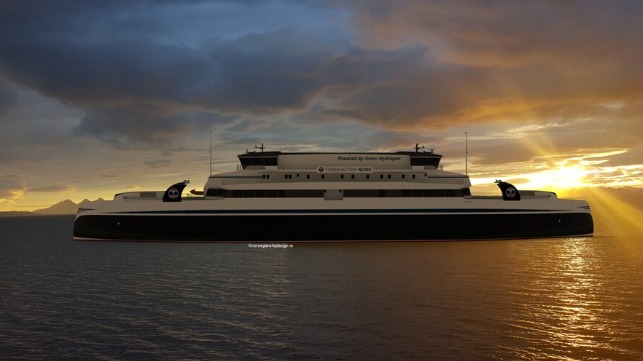Design Approval for Norwegian Hydrogen-Fueled ROPAX

A design project underway in Norway that seeks to develop the first hydrogen ferries operating long distances and exposed to the harsh environment in the northern region has received initial design approval. Lloyd’s Register presented the Approval in Principle which is considered to be a major milestone in the effort by Norwegian shipping company Torghatten Nord to introduce the ferries by 2025.
“We are very satisfied with the approval and we are proud to work together with the leading experts on hydrogen as a fuel on ships. Developing hydrogen ferries on such a long and weather-resistant stretch is a world-class climate project with great importance for the entire maritime sector and not least Bodø and Lofoten,” said Torkild Torkildsen, managing director of Torghatten Nord.
The shipping company is working with Norwegian Ship Design to develop the ferries that will meet the challenges of their ocean-going route serving the Lofoten Islands. The archipelago is located north of the Arctic Circle with the passage to the Norwegian mainland requiring a crossing of the 50-mile wide Vestfjorden.
“The ferries we are now developing are likely to set the standard for a new class of ferries powered by hydrogen,” said Gjermund Johannessen, general manager of Norwegian Ship Design. “We have evaluated a number of different solutions for the onboard hydrogen system and have come up with a unique and safe concept that takes hydrogen's properties into account.”
The design team said because of the unique challenges they had to start from scratch and develop completely new designs and solutions. LR granted the AiP based on a comprehensive risk analysis of the concept and technology.
Norwegian Ship Design said that both Lloyds Register and Torghatten Nord have done “a formidable job” to get the approval in place. They are now in full swing with the design of the vessels. Torghatten Nord expects to invest $40 to $45 million for the equipment packages for the vessels that it seeks to develop in Norway. Norwegian Ship Design emphasizes that the hydrogen-powered ships of the future will look different.
These pioneering vessels will build upon the companies’ current project which is building a battery-powered zero-emission vessel to operate on the same route. In April they ordered the construction of the double-ended ferry which is expected to set new records both for the amount of time operating on batteries and speed. Typically, the crossing from the mainland requires about one hour operating at 13 to 14 knots.
The vessel, which was ordered from the Cemre Shipyard, will measure 384 feet in length and have a capacity for 399 passengers. The batteries will be charged through high-capacity automated connections to shore power with a biodiesel generator to provide backup power to the vessels. The power and propulsion system will also be fully redundant with two independent systems so that the vessel can remain operational if either should fail.
